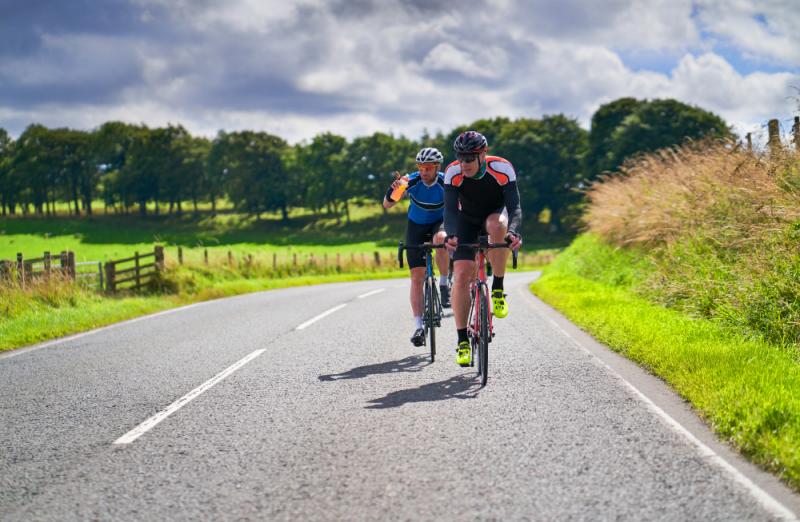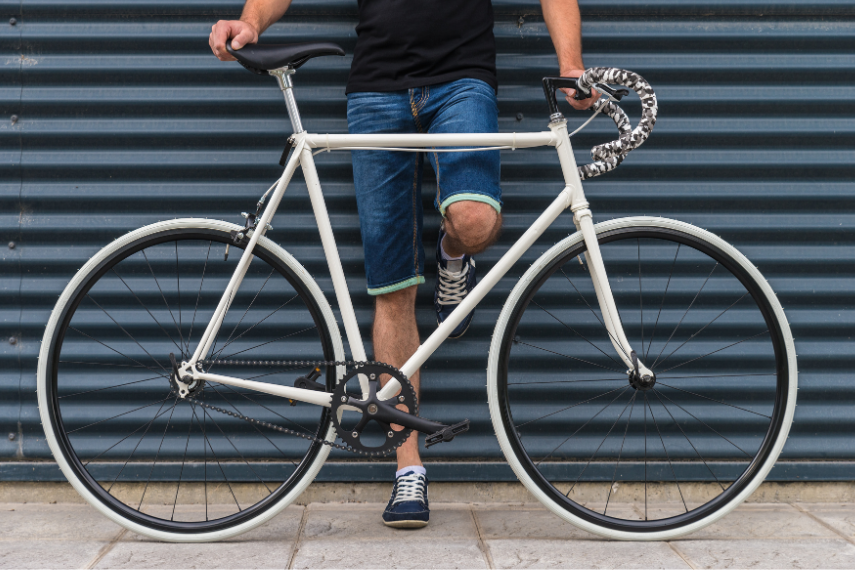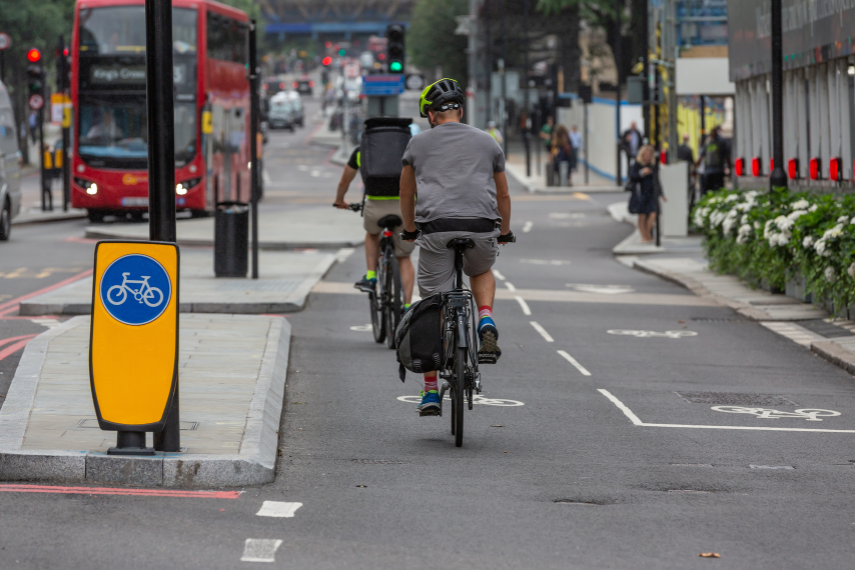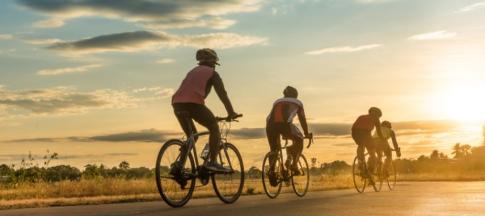
In 2023, 15% of residents in urban areas and cities across England, Wales, Scotland and Northern Ireland cycle at least once a week.
But a lot of motorists and cyclists remain confused about some of the dos and don’ts of sharing the road.
So we’ve created this guide to clear up some of the confusion, answer the most frequently asked questions about cycling on UK roads, and help everyone to stay safe.
What’s the safest way to overtake a cyclist?
For cyclists being overtaken by faster-moving traffic, it’s important to:
- maintain a steady course
- slow down, if necessary, to let the vehicle pass
- avoid obstructing drivers who want to pass
- avoid speeding up or riding unpredictably
For motorists overtaking a cyclist or another motorist, it’s important to make sure:
- the road is clear ahead
- other road users are not beginning to overtake you
- there’s a suitable gap in front of the road user when you plan to overtake
When overtaking slow-moving traffic, it’s recommended to leave a gap of at least 1.5m between you and the other vehicle.
If you can’t allow at least 1.5m, it’s advised you don’t overtake until you can.
Do cyclists have to ride single file, or can they ride side by side?
Yes, cyclists can ride side by side. In fact, there isn’t any law preventing cyclists from riding two, three, or even four abreast.
Rule 66 in the Highway Code even says that it can sometimes be safer to ride side by side. Especially when you’re in larger groups or if you’re accompanying less experienced riders or children.
It also advises cyclists to be considerate of other road users while riding side by side or in groups – mainly so they can allow faster-moving traffic to overtake them when it’s safe to do so.
Are cyclists allowed to ride on dual carriageways?
Yes. Rule 62 of the Highway Code says cyclists can ride on most roads, meaning they’re allowed to ride on dual carriageways if they “adhere to certain rules and regulations”, which include:
- riding in single file or in pairs, if necessary
- keeping to the left-hand side of the road
- using lights and reflectors when cycling during the night or in poor visibility
- wearing a helmet and appropriate reflective clothing
While it’s legal for cyclists to ride on dual carriageways, it’s generally recommended to avoid doing so, if possible.
Do speed limits apply to cyclists?
Only motor vehicles are subject to speeding laws in the UK. This means cyclists can’t be charged for speeding on a bike.
However, if cyclists are judged to be riding too quickly for the conditions, they could be charged with careless cycling or furious cycling.
Can cyclists ride fixed-gear bikes without brakes?

No. Riding a fixed-wheel bike (also known as fixed-gear bikes or fixies) without any brakes is illegal. UK law says all bikes should have at least two independent brake systems.
Fixed-gear bikes only have one gear, so can’t ordinarily freewheel. This means the back wheel only turns when the pedals are turning.
It also allows riders to lock the back wheel as a way of braking and slowing down, which counts as a braking system. But, to be legal, fixed-wheel bikes also need a brake at the front.
As a result, fixed-gear bikes that only use the back wheel as a braking system are not legal, and riding one counts as an offence.
What counts as dangerous, careless, or furious cycling?
Generally, much like driving a car, the Highway Code defines the acceptable riding standard as someone who demonstrates that they are a “competent and careful” cyclist.
To help clear things up, we’ve outlined the differences between riding carelessly, dangerously, and furiously below.
What is careless cycling?
Careless cycling is riding without “due care and attention or reasonable consideration for other road users”.
This means riding in a way that’s judged to be below that of a competent and careful cyclist.
A charge for careless cycling can incur a maximum fine of £1,000.
What is dangerous cycling?
Riding dangerously means riding in a way that causes a danger of injury to any person, or any serious damage to property.
A charge for riding dangerously can incur a maximum fine of £2,500.
What is furious cycling?
Furious cycling often relates to riding too fast for the conditions.
Because speeding offences only relate to motorists, cyclists can’t be charged with speeding (except for locations where local byelaws apply, like Royal Parks).
However, cyclists can be charged with furious cycling if they’re judged to be riding too fast for the conditions. For example, riding too quickly during bad weather, or in poor visibility.
A charge for furious cycling can come with a fine of £1,000. If a cyclist is charged with causing injury by furious cycling, they can even receive a prison sentence of up to two years.
Do cyclists have to use cycle lanes if one is available?
There are no laws or requirements for cyclists to use cycle lanes or cycle tracks when one is available.
Rule 61 of the Highway Code says that while cycle lanes and tracks are provided for cyclists’ safety, it’s up to cyclists to decide if they want to use them.
While using cycle lanes can make a cyclist’s journeys safer, they are not compulsory.
Do you have to wear hi-vis clothing while riding a bike?
Rule 59 of the Highway Code advises that cyclists should wear:
- light-coloured fluorescent clothing which helps other road users see you in daylight and poor light
- reflective clothing and/or accessories (belt, arm or ankle bands) in the dark
It’s worth noting that Rule 59 is not a law, and instead offers advice. This means that – just like wearing a helmet – the decision to wear fluorescent or reflective clothing is a personal choice.
Can more than one person ride on a bike at the same time?
This depends on whether the bike (or cycle) has been built or adapted to carry passengers.
Tandems, bikes fitted with child bike seats, and longtail cargo bikes with footrests and passenger handlebars can all legally carry passengers.
But giving someone “a backy” (letting someone sit behind you on your bike), on the other hand, is an offence.
Do cyclists have to wear a helmet?
Currently, no laws say cyclists must wear a helmet. However, Rule 59 of the Highway Code does advise cyclists to wear a helmet that can sufficiently absorb shocks.
Ultimately, wearing a helmet is a cyclist’s personal choice. But numerous studies have proven helmets can significantly reduce the severity of an injury and even save lives.
Cycling FAQs:

For answers to more of some of the most frequently asked questions, read on below.
Can cyclists ride in the middle of the lane?
In some situations, it’s accepted that riding in the middle of the lane is a cyclist’s safest option.
It can allow cyclists to avoid sudden hazards, like car doors suddenly opening in front of them. It also helps discourage drivers from overtaking when it’s unsafe to do so.
For cyclists, the Highway Code recommends making yourself as visible as possible and riding in the middle of the lane when you are:
- on quiet roads or streets
- in slow-moving traffic
- at the approach to junctions or at a narrowing in the road, where it wouldn’t be safe for drivers to overtake
In each of these situations, it’s recommended cyclists move over to the left-hand side of the lane to allow faster-moving traffic to overtake as soon as it’s safe.
If the road is clear and doing so is safe, cyclists can choose to ride on the left-hand side of the lane. This position is sometimes referred to as the “secondary position”.
Rule 169 of the Highway Code also advises that cyclists shouldn’t “hold up a long queue of traffic”. (This rule also applies to motorists.)
This doesn’t mean they must immediately pull over to allow faster-moving traffic to pass. Instead, they should pull over if a large queue of traffic is beginning to build up.
Do cyclists have to stop at red lights?
Yes. Like all road users, cyclists must:
- obey all traffic signs and traffic light signals
- not cross the stop line when the traffic lights are red
If you’re caught jumping a red light, you can receive a fine of up to £1,000 (and, for motorists, receive six penalty points on your driver’s licence).
However, the police may give you a Fixed-Penalty Notice between £30-50 instead.
For cyclists, riding through amber lights is also an offence – unless they’re so close to the stop line that stopping could cause a collision.
Can you drink and ride a bike?
Just like driving a car, it’s illegal to ride a bike while drunk or under the influence of drugs. Rule 68 of the Highway Code says you can receive a fine if you do.
If you can’t cycle correctly after drinking, or don’t have control of the bike, you can be found guilty of drunk cycling. The maximum penalty for this is £1,000.
Unlike driving a car, however:
- there is no legal limit when it comes to drinking and riding a bike: this means it’s down to the individual cyclist to make their own judgement on riding after drinking.
- cyclists aren’t obliged to take a breathalyser test: the police can’t instruct cyclists to take one, like they can with motorists. Instead, they would judge whether a cyclist is incapable of having “proper control of the cycle” by checking if they can ride in a straight line or smell of alcohol, for example.
Do bikes have to be fitted with lights?
To make sure your bike is legally compliant, it must be fitted with:
- a white light at the front of the bike
- a red light at the rear of the bike
- a red reflector at the rear of the bike
- four amber pedal reflectors (one on the front and rear of each pedal)
It’s also worth noting that all lights and reflectors on bikes are:
- only required between sunset and sunrise
- not required when the bike is stationary or being pushed alongside the road
- clean and working properly, when required
Flashing lights on the front or rear of the bike are now legal if they flash between 60 and 240 times per minute.
And while they may make you more visible to other road users, head torches and reflective ankle bands or heel strips don’t meet the legal requirements for lights or reflectors, so aren’t considered to be legal.


